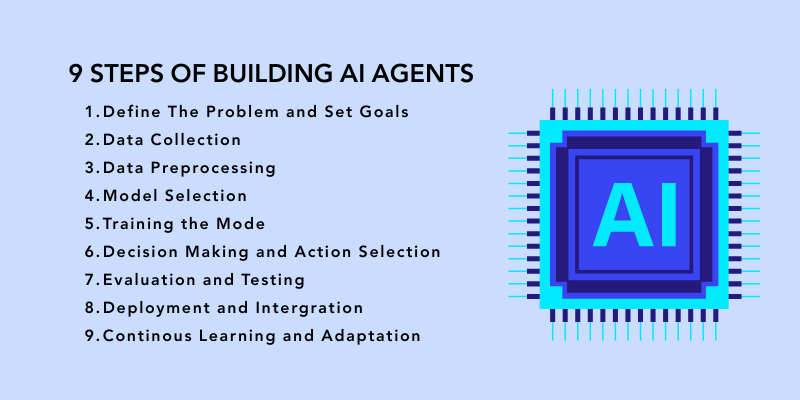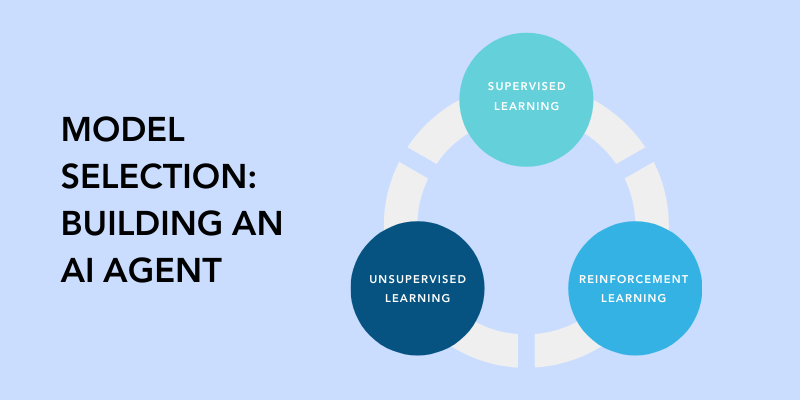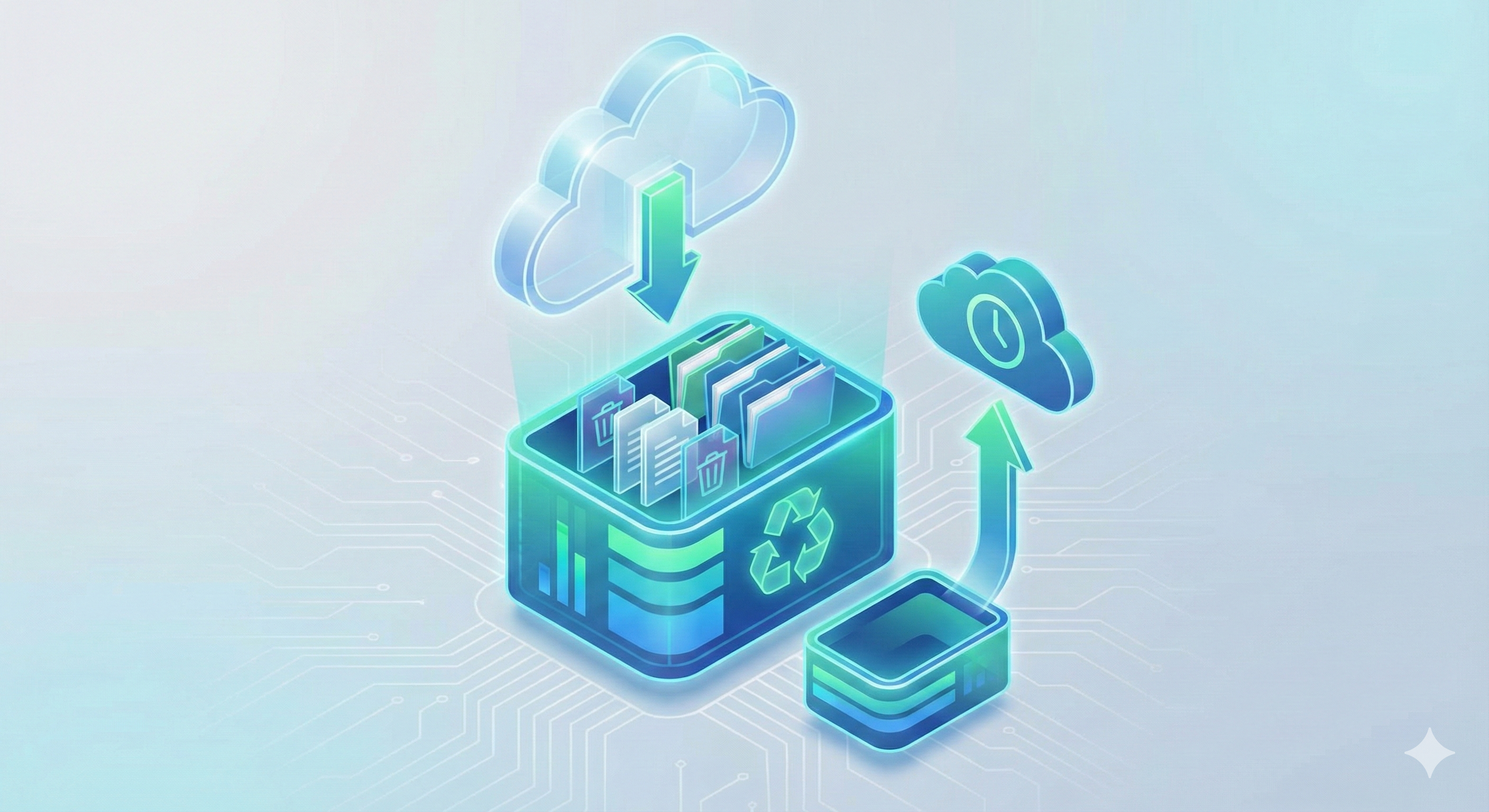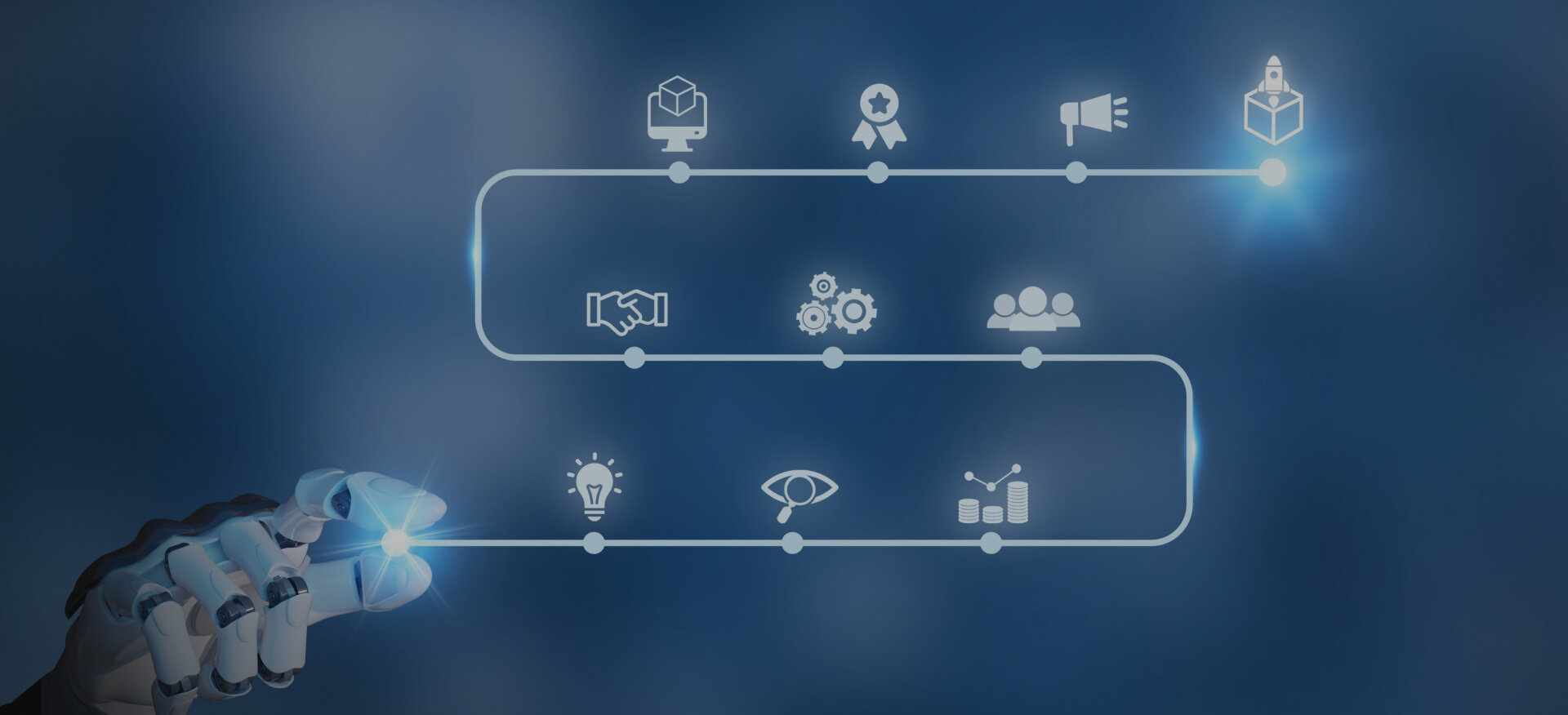An AI agent is a system designed to perceive its environment, make decisions, and perform actions autonomously or semi-autonomously based on its understanding of the surroundings. These intelligent systems simulate human-like decision-making and problem-solving capabilities, making them crucial in applications like robotics, virtual assistants, recommendation systems, and more.
If you want to know how to build an AI agent, it involves integrating several core components such as data collection, processing, decision-making algorithms, and learning mechanisms. To build an effective AI agent, these components must be carefully designed to ensure the agent can adapt to dynamic environments, optimize its actions, and improve its performance over time, especially when considering how to create an AI assistant for user interactions, showcasing how to train an AI agent. The ultimate goal is to create an agent that becomes increasingly efficient and capable as it learns and interacts with its environment.
What is an AI Agent?
An AI agent refers to a system capable of perceiving its environment, processing information, and taking actions with little or no human intervention. These agents are designed to mimic human decision-making and problem-solving by autonomously or semi-autonomously responding to stimuli from their surroundings.

They continuously analyze data, evaluate various possibilities, and execute actions that help achieve a specific goal.
In modern digital marketing services, AI agents have become essential, helping businesses target consumers effectively by analyzing behaviors and predicting needs.
AI agents are employed in various domains, including virtual assistants, self-driving cars, robots, and recommendation systems, where they interact with users or the environment to perform tasks.
With the ability to learn from experiences and improve their performance, AI agents adapt to changing conditions, making them valuable tools for automating complex processes and enhancing decision-making capabilities.
For instance, AI call center future innovations show how AI agents are being integrated into customer service platforms, streamlining support systems.
Businesses like Centric, a digital transformation agency, specialize in helping companies build and implement AI-driven solutions, ensuring they stay competitive in a rapidly evolving landscape.
So, how to build an AI agent?
Explore Our Digital Marketing Services!
9 Steps of Building AI Agents
Building an AI agent development process involves a structured approach that integrates several essential components and processes in AI agents development. From gathering data to optimizing actions, each step plays a pivotal role in creating an intelligent agent capable of making autonomous decisions.

Here are the key steps involved in building an AI agent:
- Define the Problem and Set Goals
- Data Collection
- Data Preprocessing
- Model Selection
- Training the Mode
- Decision-Making and Action Selection
- Evaluation and Testing
- Deployment and Integration
- Continuous Learning and Adaptation
Let’s explore these steps in detail in our AI agent guide.
1. Define the Problem and Set Goals
The first step in building an AI agent is to clearly define the task it will perform, such as developing a recommendation system, creating a self-driving car, or designing a chatbot.
Understanding the problem the agent will solve helps in tailoring its design and functionality. Once the task is identified, measurable goals should be set to evaluate its effectiveness.
These goals could include performance metrics like accuracy, speed of decision-making, or task completion rate.
For example, a company focused on fintech software development might define the agent's role in detecting fraudulent transactions.
Establishing clear objectives and scope ensures that the agent is both realistic and focused on solving the problem at hand.
- Define the task (e.g., recommendation system, self-driving car, chatbot).
- Set measurable goals (e.g., accuracy, decision-making speed, task completion).
- Identify the agent's boundaries and limitations (e.g., computational constraints, environmental factors).
2. Data Collection
Data collection is a critical step in building an AI agent, as it provides the foundation for the agent’s learning and decision-making.
The first task is to identify the types of data that are relevant to the problem the agent is solving. This could include structured data (e.g., databases, spreadsheets), unstructured data (e.g., text, images), or real-time data (e.g., sensor readings, live user interactions).
Once the data is gathered, it may need to be labeled and organized, particularly if the agent is using supervised learning for learning based agent in AI.
Additionally, AI is increasingly being used in tracking Google keyword ranking and what are five marketing strategies that retailers spend half of their annual budget on to predict trends and behaviors.
This means assigning labels to data points so the model can learn from the relationship between input features and output targets.
In Addition, the data should be structured to ensure it is easily accessible and ready for processing, which may involve transforming raw data into a format suitable for machine learning algorithms.
- Gather relevant data, such as user behavior, environmental data, sensor data, or historical data.
- Label and organize the data if using supervised learning.
- Structure the data for efficient access and processing.
Explore Our Web Design & Development Services!
3. Data Preprocessing
Data preprocessing is a vital step in preparing data for training an AI agent. The process begins with data cleaning, which involves eliminating noise, irrelevant information, and addressing missing values to ensure that the data is clean and reliable.
Next, feature engineering focuses on identifying and extracting the most relevant features or attributes from raw data, transforming them into more useful variables to enhance the model’s performance.
Finally, normalization and transformation ensure that the data is in the correct format for the model to process effectively.
These preprocessing techniques make the data more structured and ready for the model to learn from.
- Eliminate noise, irrelevant data, and handle missing values.
- Identify and extract relevant features to improve model learning.
- Scale and encode data for proper model compatibility.
4. Model Selection
Model selection is an importantl step in building an AI agent, as it determines how the agent will learn and make decisions. The first task is to choose the right algorithm, selecting a machine learning or deep learning model that is best suited to the problem at hand, such as classification, reinforcement learning, or regression.

When considering the choice of models, companies may look to tech marketing agency services to assist in determining the best AI tools for their specific goals, particularly during AI agent implementation and for tasks that involve analyzing large data sets. There are different types of models to consider based on the task:
- Supervised Learning: This is used when labeled data is available, and the goal is to predict or classify based on known outcomes.
- Unsupervised Learning: Ideal for tasks like clustering or anomaly detection, where the data is not labeled and the model must find patterns or groupings.
- Reinforcement Learning: Suitable for agents that learn through interactions with their environment, such as in robotics or self-driving cars, where actions are optimized through trial and error.
In Addition, businesses must decide whether to use pre-built models or create custom models.
Pre-trained models can offer quick solutions for standard problems, while custom models may be required for more specialized or complex tasks, providing flexibility and higher precision tailored to specific needs.
5. Training the Model
Training the Model involves several crucial steps to ensure the AI agent learns effectively:
- Training Process: The model is trained using labeled data, adjusting its parameters or weights to identify patterns and make accurate predictions based on the input. For example, businesses looking for web design and development services often leverage AI agents trained on customer interaction data to improve user experience. Hyperparameter tuning and cross-validation help ensure the model’s optimal performance.
- Hyperparameter Tuning: In this phase, hyperparameters like the learning rate, batch size, and number of epochs are fine-tuned to enhance the model's performance and efficiency.
- Cross-Validation: Validation datasets are used to prevent overfitting by ensuring the model can generalize well to new, unseen data, thus improving its ability to perform accurately in real-world scenarios.
6. Decision-Making and Action Selection
Decision-making and action selection are essential for the AI agent to perform tasks autonomously.
To enable effective decision-making:
- Implement Decision-Making Logic: Algorithms are created to help the agent make informed decisions based on the data it receives, allowing it to respond effectively to different inputs.
- Reinforcement Learning for Decision Making: If the agent needs to improve through trial and error, reinforcement learning techniques are used. This allows the agent to learn from its actions and optimize future behavior based on rewards and penalties. For AI to be effective in advertisement examples, the agent must continuously adapt and select actions that maximize engagement and conversions, akin to how AI tools are used to track users across the web for more personalized advertising.
- Action Selection: Systems are built to help the agent choose the best possible action based on its learned policy. Techniques like Q-learning and policy gradients are applied to ensure that the agent selects the optimal actions for its goals.
These processes work together to enable the AI agent to make intelligent, adaptive decisions that improve its performance over time.
7. Evaluation and Testing
Evaluation and Testing are crucial to ensure the AI agent operates effectively and meets its objectives.
To evaluate its performance
- Test Model Performance: Assess the agent's performance against defined metrics such as accuracy, efficiency, and user satisfaction to ensure it aligns with the desired outcomes.
- Real-World Testing: The agent should be tested in real-world scenarios or simulations to verify its robustness and scalability, ensuring it can handle dynamic environments and large-scale operations.
- Iterative Improvements: After testing, analyze the results, identify any areas for improvement, and retrain the model if needed to fine-tune its performance and address any shortcomings.
8. Deployment and Integration
Deployment and Integration are key steps to ensure the AI agent operates effectively in real-world environments.
After training, the agent is deployed into the production environment, whether it’s on the cloud, edge devices, or within web applications to start executing tasks in real-time.
Additionally, when developing AI-driven systems, companies often integrate them with other tools, such as best website builders for small business, to enhance overall performance and improve user engagement.
Once deployed, it is crucial to integrate the agent with other systems, such as software, platforms, or hardware, to create a seamless and efficient experience when you create AI agent.
This integration enables the agent to work in sync with other components, like databases, APIs, or IoT devices, which is an important step in AI agent development.
Additionally, real-time monitoring is essential to track the agent’s performance, ensuring it adapts to changing conditions, addresses emerging issues, and continues to perform optimally.
By combining deployment, integration, and continuous monitoring, the AI agent can function effectively within a dynamic environment.
9. Continuous Learning and Adaptation
Continuous Learning and Adaptation are vital for ensuring that an AI agent remains effective and improves over time. To achieve this:
- Implement a Feedback Loop: The agent learns from new experiences or feedback, which allows it to refine its decision-making process continuously.
- Model Retraining: Periodically retraining the model with new data ensures that the agent stays updated and relevant, maintaining its accuracy as new information becomes available.
- Scalability and Adaptation: The agent must be able to scale to handle increased workloads and adapt to changing environments, ensuring it remains effective in dynamic conditions.
By implementing these strategies, the AI agent can continuously evolve, becoming more efficient and capable of handling a variety of tasks over time, showcasing how to train AI agent.
FAQs: How To Build An AI Agent
What is an AI agent, and how does it work?
An AI agent is software that performs tasks requiring human-like intelligence. It uses machine learning and natural language processing to analyze data and improve over time.
How do I build a simple AI agent?
To build an AI agent, define its purpose, choose a framework (like Python with TensorFlow), train it using a dataset, and enable it to interact with users.
What tools are needed to create an AI agent?
Use Python, TensorFlow, Keras, or PyTorch for machine learning, and NLTK or spaCy for natural language processing tasks.
How do I train an AI agent with machine learning?
Train an AI agent by providing a labeled dataset and using supervised or unsupervised learning methods. The agent learns to make decisions from the data.
What are the challenges of building an AI agent?
Challenges include gathering quality data, selecting the right algorithms, addressing ethical issues like privacy, and ensuring the agent continually improves.
Conclusion
Now that you know how to build an AI agent, it’s clear that the process involves several essential steps. First, you need to define the problem the agent is designed to solve, followed by collecting relevant data for training. Once the data is processed, the next step is training the model, including understanding how to train an AI model, and deploying it into the production environment.
In fields like web design and development services, AI agents are now a pivotal component in building smart, adaptive systems that are capable of scaling. Businesses often need to consider factors like How Much Does Social Media Marketing Cost when budgeting for such solutions. Continuous learning and improvement are key to ensuring that the agent adapts to new experiences and maintains its effectiveness over time.
AI agents are already revolutionizing numerous industries. Real-world applications include customer service chatbots that provide instant support, autonomous vehicles that drive without human intervention, and AI in healthcare that helps in diagnosing diseases and managing patient care. These applications demonstrate the versatility and growing influence of AI agents in diverse sectors.
Looking ahead, the future of AI agents holds tremendous potential. As technology evolves, AI agents will become more intelligent, adaptable, and capable of handling increasingly complex tasks. Trends such as deep learning, reinforcement learning, and edge computing will expand their capabilities, further embedding them into industries like finance, manufacturing, and education. The future promises greater automation, enhanced decision-making, and more personalized experiences across various sectors.









